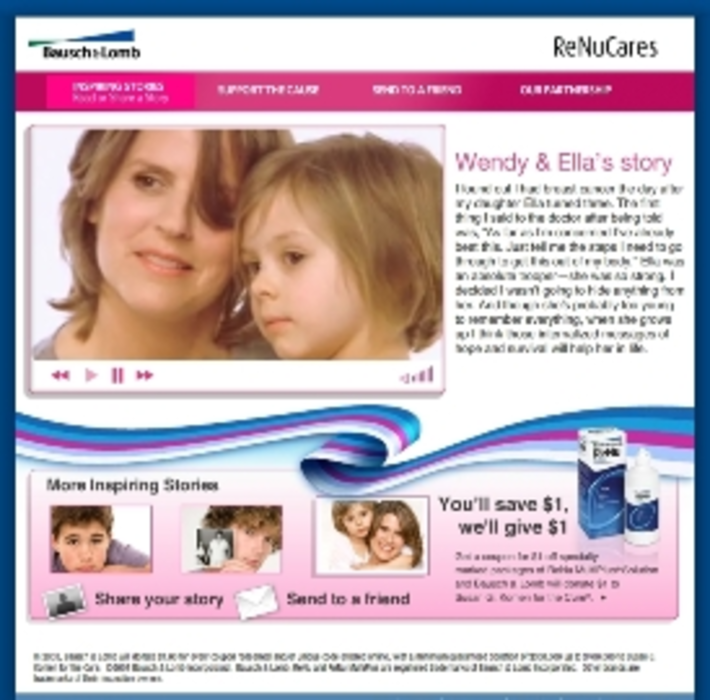Kicking off “Conference Call,” DMNews’ new online exclusive feature series, Kevin McKeefery chats with Gene Lewis, partner and director of Web site development at agency Digital Pulp; and Kimberly Jones, senior manager, interactive marketing at leading eye care supplier Bausch & Lomb. The two companies have worked together since 2005 on online marketing and Web sites for the brand – both primary sites and microsites for initiatives and partnerships. Jones and Lewis discuss Bausch & Lomb’s current efforts as well as the evolution of their working relationship.
DMNews: Can you talk about the evolution of each of the sites as far as how the products are presented and what you’re trying to achieve with each one?
Lewis: We listen to the original briefing on the product and we try to pull out the big important elements we think people will respond to. In the case of PureVision [a new microsite for the contact lens brand] one of the guiding principles was originally sort of a method of delivering a high definition vision experience. We extracted from that additional benefits – that’s how the “See, Feel and Try” navigation started. The essence of the lens was clear, beautiful, dynamic vision – that’s the imagery you see on the site. It’s all about points of focus and level of detail with lights blinking in the city. It makes you feel as if you’re experiencing the world through that lens, and that’s the essence of that product.
Jones: What we’re trying to do is create that experience and bring the products to life in a way that you can’t do any other way – it’s not just about listing products, features and benefits. It’s bringing them to life.
Can you talk about the searchability of the Bausch & Lomb site, its navigation, and its design?
Lewis: We don’t want to create a puzzle for users. We’re not trying to challenge them into coming up with new vocabulary for what a section is called. It should be clear, it should be easy to navigate, it should be incredibly efficient in terms of how it loads. Things like video playing right away on the RenuCares site, that’s very optimized – a very quick Web load. We send [the work] to our families and friends to make sure they all have a similar experience to what was described in the initial brief.
Jones: Because so many of our products are not consumer packaged goods, people don’t have an opportunity to really find out more information unless they see their eye care professional, and we know most people only go to their eye care professional once every year or two, so the Web sites we have developed with Digital Pulp and other online components have become the call to action in all of our offline communications. Whether it’s to print a coupon or enter a unique code or make a donation to the cause, the Web site is really the fulfillment mechanism.
DMNews: Can you talk about some of the current work you’re doing now, including ReNucares.com, which leverages Bausch & Lomb’s relationship with the Susan B. Komen Breast Cancer Foundation?
Lewis: The ReNucares.com site is one of the first we’ve done that is not focused so much on product as it is on extending the brand and showcasing what Bausch does in the more traditional world. We started hearing these stories being told and said “God, this is powerful stuff.” It evolved into suddenly doing media that Bausch hasn’t done a lot of.
Jones: It’s a perfect example of how we’re using the Web to complement our offline media tactics, especially with print ads. We’re running a significant print campaign for this effort but in a print ad you can only say so much and it’s hard to get that emotion, and we’re able to send people to the Web site and give them that [rich] experience.
DMNews: In the three years you have been working together, how has the relationship between Bausch & Lomb and Digital Pulp evolved?
Lewis: The thing that has changed the most is the level of trust, anticipation and understanding between two teams. We understood immediately the value of talking through the reasoning behind everything we do. There’s always a defense for it, always a purpose.
Jones: After working with us for three years, Digital Pulp really understands expectations and can anticipate our reactions not only when it comes to creative things but also things that may be of concern to our legal department or regulatory department.
DMNews: How fast can things turn around if Bausch & Lomb wants changes to the sites?
Lewis: We’ve learned that approvals are best served when they’re funneled through as small a pool as possible, so Kimberly end ups being either the voice of the approval process at Bausch or the approver herself.
DMNews: Can you tell me about a struggle the teams overcame in terms of working together?
Lewis: One of the biggest challenges is to translate what Bausch wants to do into something that the Web really is made for. A complex process like looking for a doctor, or combining a database of things that may not be on the Web – there are lots of techniques and methodologies we can implement to translate what it is Bausch wants to accomplish.
Jones: As a group, we’ve learned not to shortchange that initial discovery phase of work – really making sure we nailed the brief, really understanding what the objective of the project is, who the target is, what the message is, so there aren’t any surprises at the back end of the process.








